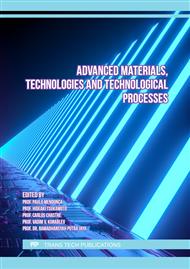p.3
p.11
p.19
p.29
p.35
p.41
p.49
p.55
Properties Investigation of Steel-TiC Composite Material Formed during Selective Laser Melting Process
Abstract:
This paper is devoted to the parts formation from composite materials in the process of selective laser melting. Composite materials are of great interest, as they allow to combine properties of the composite constituent elements and expand parts manufacturing possibilities. Parts manufacturing from composites by selective laser melting (SLM) is interesting because the composite material is formed during the build process. There is a wide opportunity to combine the composition of the raw material for powder. Special attention is paid to composites with TiC-reinforced steel matrix. The results of manufacturing samples with different contents of carbide reinforcing elements are presented in this paper. The region of selective laser melting build parameters is highlighted, in which an almost continuous structure with a minimum number of defects is formed. Mechanical tests of the built samples were carried out. The influence of the TiC concentration on the mechanical properties, as well as on the change in the mass of the samples, was revealed.
Info:
Periodical:
Pages:
19-25
Citation:
Online since:
March 2023
Price:
Сopyright:
© 2023 Trans Tech Publications Ltd. All Rights Reserved
Share:
Citation:


